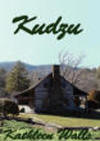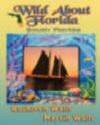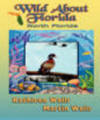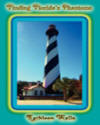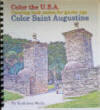
The Not Too Little Zoo That Can
Story and photos by Kathleen Walls
Gulf Shores Zoo became a household word as "The Little Zoo That
Could" when a prime-time documentary told how the zoo's saved
its animals in 2004 before Hurricane Ivan struck Gulf Shores.
It all began in 1989 when Joey Ward built a small, community
zoo on his family's land just a mile from the beach. He named
it Zooland Animal Park. By 2000 it had grown and was renamed
The Alabama Gulf Coast Zoo.

When Hurricane Ivan took aim at Alabama's coast in 2004,
Gulf Shores Zoo
moved all its animals, except Chucky the alligator, to safety
during. Prior to this no
US zoo
has ever been completely evacuated for a disaster. Patti Hall,
Zoo Director,
realized Gulf Shores and Orange Beach were the bulleye for the
Cat 3 Ivan. If the animals were left in the zoo, they probably
would not survive Ivan. Within 36 hours, Patti and her staff
moved over 265 animals 20 miles inland to her own property.
On September
16th, Hurricane Ivan made landfall and completely wiped out The
Alabama Gulf Coast Zoo leaving it under 14 feet of water Not
one animal life was lost in the transport or during the
relocation They found
Chucky safe when they could return home. Chucky was the only
one in Alabama that seemed to enjoy all the flooding Ivan
brought. He is the zoo's oldest resident.

In
2005 a
13-episode TV series was made and sold to Animal Planet
and
On February 15th 2006,
The Little Zoo That Could
debuted bring instant fame to the zoo.
It reopened only 14 months after Ivan, but Ward and the staff
knew it was sitting on disaster because of its location.
Hurricanes Dennis and Katrina put them at risk again.
Then in 2007, a gift from Animal-lovers Clyde Weir and his
daughter Andrea of 25 acres of prime Gulf Shores land located
four miles from the water offered safety.
The Deepwater Horizon Oil Spill slowed the move as tourism
tanked but thanks to help from
the Ward family, the move is finally accomplished. The zoo
opened at new location in March 2020 and was voted the "#1 Zoo
in Alabama" for two years running.

I visited recently and was amazed at how the zoo has grown and
improved. I wanderd around the zoo and admired its residents in
their spacious well-kept habitats.

A family of lemurs inhabits their own island near the front
entrance. Chucky was sunning himself besides his watery
habitat. Two giraffes were parading regally about their
enclosure. A fluffy white wolf was acting like a big dog. Most
of the big cats were doing what cats do best, napping.
I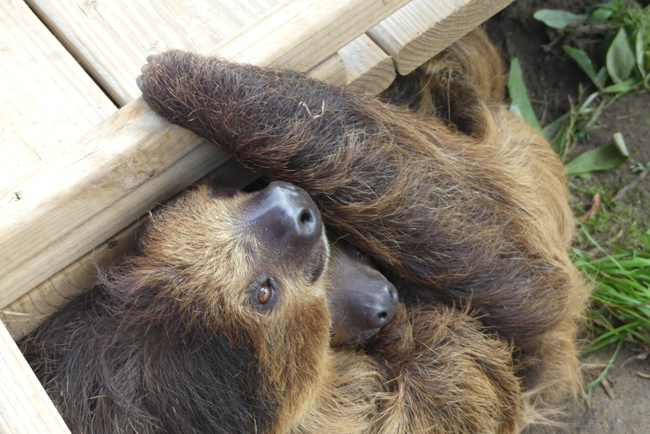 I
took the Sloth Encounter in South American
Adventure exhibit and got to pet the male Southern two-toe
sloth, Herbert, as he hung on his rope set, and watch the
female. Sylvia, with her baby clutched to her breast, at close
range. The newest sloth, Petron, was eying me from his perch in
the sloth house window. The macaw, Pumpkin, which shares the
enclosure with the sloths seemed to have a strong bond with the
keeper, Brittany. Aside from the sloths, I got to meet a few
tortoises who also share the space, and even pet them. Brittany
gave a lot of information about the animals' habits and diet.
Besides the Sloth Encounter, they offer Lemur Encounters and
Kangaroo Encounters.
I
took the Sloth Encounter in South American
Adventure exhibit and got to pet the male Southern two-toe
sloth, Herbert, as he hung on his rope set, and watch the
female. Sylvia, with her baby clutched to her breast, at close
range. The newest sloth, Petron, was eying me from his perch in
the sloth house window. The macaw, Pumpkin, which shares the
enclosure with the sloths seemed to have a strong bond with the
keeper, Brittany. Aside from the sloths, I got to meet a few
tortoises who also share the space, and even pet them. Brittany
gave a lot of information about the animals' habits and diet.
Besides the Sloth Encounter, they offer Lemur Encounters and
Kangaroo Encounters.

The zoo now is home to 300 animals, 22 are on the Endangered
Species List, including their Bengal tigers Rajah, Rani, and
Omar. They have a beautiful black leopard named Katrina that
was a gift from naturalist, Jack Hanna. There's a Petting Zoo
and educational and fun stage shows where you can learn more
about the animal residents.

For some variety, you can do the zipline, ride the carousel,
walk through an aviary or a butterfly garden. If you are tired
of walking, you can ride the Safari cars, or pick up a snack at
Savannah Manor, or enjoy a full meal at Safari Club Restaurant.

When you visit the Alabama Gulf Coast, this is a must see.
























